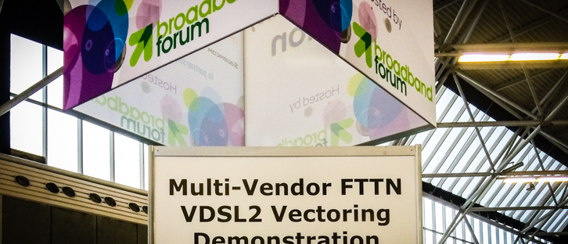Vectoring steals the show at BBWF
The Broadband World Forum 2014 is always a great place to get a sneak peek into the latest telecom technologies and catch the hottest market news first-hand. Network Functions Virtualization (NFV) and Software-defined Networking (SDN) are both trending these days. However, it’s good ol’ copper that’s been stealing the show lately with how the copper pair used in legacy access networks can be optimized and maximized for the current and future needs of end-users in their homes.
At the BBWF it was possible to have a close look at what the most innovative companies in the telecom industry have been working on, what concepts (such as XG-FAST) are in the works and what practical ways are coming up to push Gbit/s over the simple twisted copper pair using G.Fast technology.
Another approach that demonstrated strong value is the use of VDSL2 technology in FTTN (Fiber to the Node) application. VDSL2 deployment shows constant growth around the world, while research keeps on adding improvements to the system.
One of the main issues in the use of VDSL2 applied to FTTN is the negative impact of crosstalk noise from user modems on the overall quality of the service (QoS). More active modems infer more crosstalk noise and down goes the quality of the connection. To overcome this limitation, a new system called Vectoring has been devised with a special algorithm that’s able to cancel far-end crosstalk noise coming from the remote modem.
Vectoring was under trial and confined to the labs for a long while, but now it’s ready to go out there and take on the world. Tier 1 operators as well as OLO (Other Licensed Operators) can’t keep their hands off it to examine interoperability issues, the impact of this system and how vectoring can improve video delivery and QoS upon mass deployment in the field. You can imagine the effervescence when for the first time ever at the BroadBand World Forum–thanks to the contribution of multiple vendors – it was possible to watch a real-life application of the VDSL2 Vectoring system.
Alcatel-Lucent, ADB, Sagemcom, EXFO and Telebyte recreated at the Forum’s Interoperability Pavilion an actual situation under real-world conditions with a VDSL2 vectored DSLAM, a copper pairs binder emulator, 42 CPEs from two different vendors, 4 standard IPTV STB connected to 4 CPEs, a noise injector to simulate interferences such as impulse noise, RFI, mechanical interruptions, etc., with EXFO’s FTB-635 test equipment to analyze performance and help the troubleshooting of the noise problems.It was possible to watch a real-life application of the VDSL2 Vectoring system.
It was no small task to install the entire setup and reproduce a real FTTN application in such short notice: hundreds of connections, an entire wall of main plugs, an active DSLAM with an IPTV multicast multi-channels station, management of 42 virtual customers and their CPEs configuration. But we made it, and it was an exciting endeavor that caught the attention and interest of the attendees.
The live demonstration attracted lots of operators, eagerly asking many questions. We met operators from Europe, as well as representatives from Central and South America and Far East, confirming worldwide interest in this technology.
People wanted to see what can be achieved when Vectoring is enabled along various distances and what practical effect results from multiple CPEs connected with longer VDSL2 synchronization time. Operators waited for each short experiment with variable loop length or the noise level and were very happy at the end to have been privy to a real-life case (note: in a vectored system, the algorithm to cancel the crosstalk is very complex and requires a lot of tests and calculations. Moreover, the more active CPEs present, the higher the time to get physical layer synchronization).
One of the most common questions was around the impact of the noise. More specifically, it was about how to capture and process the impulse noise.
Indeed impulse noise is the biggest enemy of a VDSL2 vectored installation, since it is very difficult to address this issue. That’s why visitors at our booth showed such deep interest in our professional solutions that provide unique tools to capture, analyze and process noise in the copper pair, whether classic crosstalk wideband noise or complex impulse noise.
It was a successful 3-day forum and the multi-vendor pavilion was a great and unique experience which demonstrated that interoperability is key to build better, more efficient networks and to enhance customer experience.
For more information, make sure to read the Capturing and Analyzing Impulse Noise application note. You can also read the DSL Testing Reference Guide.




